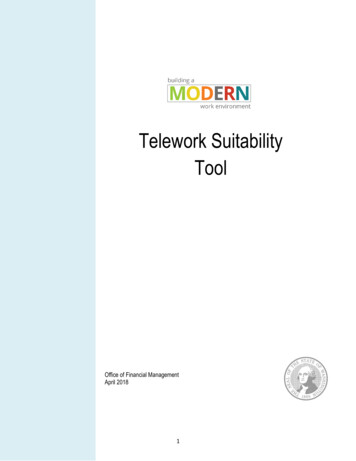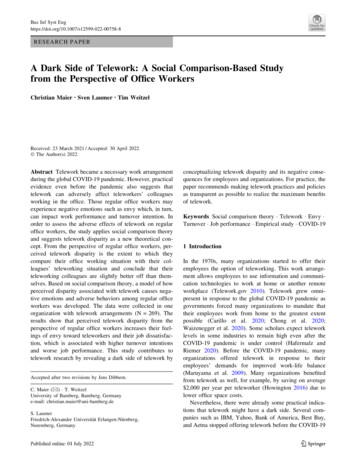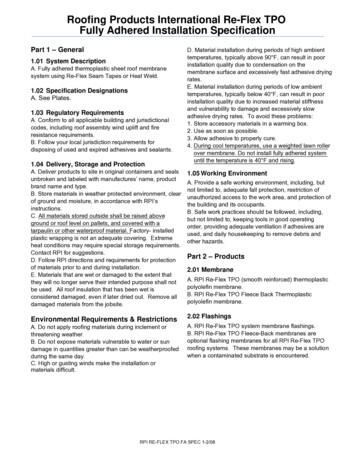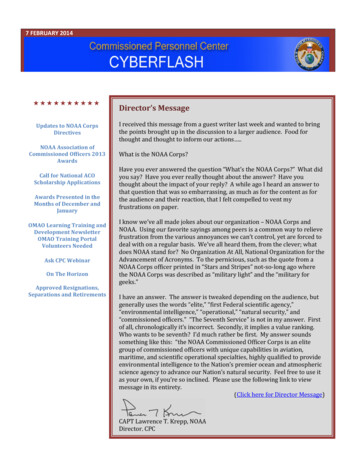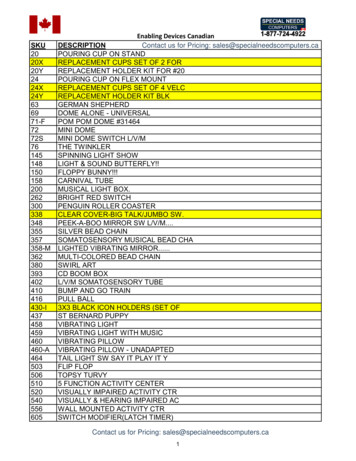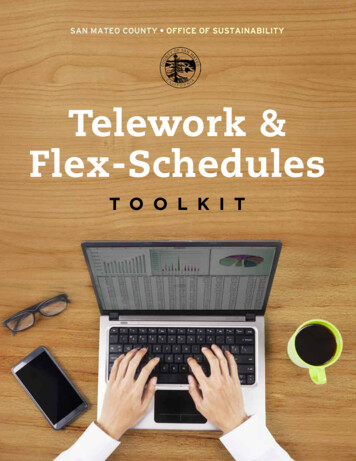
Transcription
SAN MATEO COUNTY Office of SustainabilityTelework &Flex-SchedulesT o o l k i t
This Telework Toolkit provides general information and sample materials that may be consulted by employersconsidering the development or implementation of a telework program. In making these materials available, theCounty of San Mateo is not recommending that your company or agency take any specific action or adopt anyspecific policy or practice. Rather, this toolkit identifies issues which may arise when implementing a new teleworkpolicy, and is not intended to be, and is not, an all-inclusive manual on telework and the many issues related to it.Your company or agency should undertake independent analysis of these issues and your specific circumstancesin connection with the adoption of a telework program. Due to the complex nature of the federal, state, and locallaws and regulations that may be implicated by a telework program, you are urged to consult knowledgeable legalcounsel in the course of developing own policies and practices. While the County of San Mateo has endeavoredto ensure the accuracy of the materials in the Telework Toolkit, each company or agency that uses the toolkit mustdetermine if the toolkit contains any errors, omissions or misstatements prior to reliance upon the materials.
S A N M A T E O C O U N T Y O f f i ce o f S usta i na b i l i tyTelework &Flex-SchedulesT o o l k i t
Table of Contents1 .Introduction . . . . . . . . . . . . . . . . . . . . . 1Phase 2: Implementation Phase. . . . . . . . . 37Phase 3: Evaluation Phase. . . . . . . . . . . . . . 392 .What is Telework?. . . . . . . . . . . . . . . 3Telework Defined. . . . . . . . . . . . . . . . . . . . . . 3Common Misconceptions. . . . . . . . . . . . . . . 3Informal versus FormalTelework Programs . . . . . . . . . . . . . . . . . . . . 4Alternate Work Schedules atthe County of San Mateo. . . . . . . . . . . . . . . 5Alternate Work Schedule Policies . . . . . . . 83 .The Benefits of Telework . . . . . 136 T. echnology, Equipment,.and Infrastructure. . . . . . . . . . . . . . . 45Digitizing Records. . . . . . . . . . . . . . . . . . . . . 45Technology and EquipmentBest Practices. . . . . . . . . . . . . . . . . . . . . . . . . 45Data Confidentiality Best Practices. . . . . . 46Technology for Telework . . . . . . . . . . . . . . . 48Technology Resources for Meetings,Communication, and Collaboration. . . . . . 49Organizational Benefits . . . . . . . . . . . . . . . . 13Return on Investment. . . . . . . . . . . . . . . . . . 16Environmental Benefits. . . . . . . . . . . . . . . . . 17Employee Benefits. . . . . . . . . . . . . . . . . . . . . 17Telework Barriers. . . . . . . . . . . . . . . . . . . . . . 17Hoteling Best Practices Case Study . . . . . 184 C. ounty of San Mateo.Case Studies. . . . . . . . . . . . . . . . . . . . . 217 .Risk and Liability . . . . . . . . . . . 51Workers Compensation . . . . . . . . . . . . . . . . 51Other Telework Policy Issues. . . . . . . . . . . . 538 C. ounty of San MateoTraining Content. . . . . . . . . . . . 55Training for EmployeesConsidering Telework. . . . . . . . . . . . . . . . . . 55Health Policy & Planning Division. . . . . . . . 21Training for EmployeesApproved to Telework. . . . . . . . . . . . . . . . . . 56Aging and Adult Services Division. . . . . . . 24Training for Supervisors and Managers. . . 57Human Resources Department. . . . . . . . . . 265 H. ow to Get Started –.Launching a Pilot Program. . . . . . 29Phase 1: Planning Phase. . . . . . . . . . . . . . . . 309 .Sample Materials. . . . . . . . . . . . . . . . 59Sample Policies. . . . . . . . . . . . . . . . . . . . . . . . 59County of San MateoAdministrative Memo. . . . . . . . . . . . . . . . . 59Sample Departmental Policy. . . . . . . . . . 61
Sample FAQs. . . . . . . . . . . . . . . . . . . . . . . . 63Individual Consultation Questions . . . . . 84Sample Agreements . . . . . . . . . . . . . . . . . . . 66Approval and Monitoring Tips forSupervisors. . . . . . . . . . . . . . . . . . . . . . . . . . 85Telework Agreement Template. . . . . . . . 66County of San MateoTelework Agreement . . . . . . . . . . . . . . . . . 69County of San MateoTelework Request . . . . . . . . . . . . . . . . . . . 73Home Office Safety Self-CertificationChecklist Template. . . . . . . . . . . . . . . . . . . 76How to Manage for Results/Performance/Accountability. . . . . . . . . . . . . . . . . . . . . . . 86Helpful Handouts. . . . . . . . . . . . . . . . . . . . . . 88Mileage Calculator . . . . . . . . . . . . . . . . . . . 88How to Block a Phone Number. . . . . . . . 88How to Map Shared Drives. . . . . . . . . . . . 89County of San Mateo Safe and EffectiveTelework Environment Checklistand Self Certification. . . . . . . . . . . . . . . . . 78Monitoring and Evaluation. . . . . . . . . . . . . . 90For Employees. . . . . . . . . . . . . . . . . . . . . . . . 82How to Evaluate a Program’s Success. . 90Tips for Planning Your Telework Day. . . 82Overview. . . . . . . . . . . . . . . . . . . . . . . . . . . . 90Focus Group Materials. . . . . . . . . . . . . . . . 91Work Planning & Communication Tool . 83For Supervisors. . . . . . . . . . . . . . . . . . . . . . . . 8410 Additional Resources . . . . . . . . . . . 99
1. INTRODUCTIONAlternate Work Schedules have a number of benefits for both employers andemployees. Alternate Work Schedules may include programs like voluntary timeoff, flex-schedules—which allow for 9/80 or 4/10 work weeks—or flexible hours toallow employees to come in and leave either earlier or later. They may also includetelework, which allows employees to work offsite, often from home. Employeestend to see these programs as benefits, allowing them greater flexibility, work/lifebalance, and cost savings from less driving. Employers often see these programsas potential recruitment and retention tools, a new way of doing business, offeringcontinuity of services during emergencies, and a way to reduce greenhouse gasemissions for a relatively low cost.The County of San Mateo is a large employer, withmore than 5,000 employees. While the County hadoffered telework and flex-schedules for a numberof years, a 2009 employee survey showed that only196 employees participated in telework, with mostteleworking less than once a week. In the County’s2010 Greenhouse Gas Inventory for GovernmentOperations, employee commutes were the secondlargest contributor to greenhouse gas emissions,accounting for 33% of the County’s greenhouse gasemissions from government operations. In the County’s2012 Climate Action Plan for Government Operations,the County identified Alternate Work Schedules as onecost-effective strategy for reducing greenhouse gasemissions associated with employee commutes.The San Mateo County Transit District (SamTrans)received a Metropolitan Transportation Commissiontoolkit as a resource for other local governments(MTC) Climate Initiatives Grant to pilot implementationand businesses in the region interested in exploringof a suite of transportation demand managementAlternate Work Schedules. With 71 percent ofstrategies through the Connect, Redwood City!commuters in San Mateo County driving alone to work 1program. As a partner agency, the County receivedand growing traffic congestion, these resources cangrant funding in 2012 to re-launch its telework andhelp agencies and businesses consider how they mightflex-schedules and to develop trainings and a teleworkimplement Alternate Work Schedules.1“Indicators for a Sustainable San Mateo County.” Sustainable San Mateo County. 2014.San Mateo County Telework & Flex-Schedules Toolkit1
2. WHAT IS TELEWORK?The terms telecommuting and teleworking were first coined in 1973 by JackNilles, a former rocket scientist from California, during the first documented pilottelecommuting project. Mr. Nilles organized and led an interdisciplinary team at theUniversity of Southern California to develop and test telecommuting in a real-worldenvironment with a major national insurance company.Telework Definedmay be done occasionally or on a routine schedule,depending on the type of work done by theThe original definitions of these terms are:employee and the needs of the department. Telework: ANY form of substitution of informationtechnologies (telecommunications and computers)for work-related travel.In practice, “telework” is generally considered avoluntary work arrangement that allows employees towork at home, or other approved alternate worksite, Telecommuting: That portion of teleworking thatduring normal business hours.applies to the daily commute to and from work-aprimary source of traffic congestion, air pollution andloss of productivity in urban areas.Common MisconceptionsThere are some very common misconceptions aboutToday, these terms are often used interchangeably,telework that can prevent an organization fromwith some preferring telework since the emphasis ismoving forward with implementing a program. Theseon “work,” rather than “commuting.” A more recentmisconceptions are often part of the underlying causedefinition of telework can be found in the federalof management resistance (the single biggest barrierTelework Enhancement Act of 2010, which establishesto teleworking), so it’s important to understand andrequirements for teleworking throughout the federaladdress these issues in order to get management buy-in.government:1. If I let one person telework, then all ofmy employees will want to do so.The term “telework” or “teleworking” refers toa work flexibility arrangement under which anemployee performs the duties and responsibilitiesof such employee’s position, and other authorizedactivities, from an approved worksite other thanMany people prefer coming to the office every daybecause they either like the social aspects ofwork, they do not think they would bedisciplined enough to work fromthe location from which the employee wouldhome, or they want to maintainotherwise work.clear boundaries betweenThe County of San Mateo’s Alternate Work Schedulework and home. Studies havePolicies (2012) describes telework as follows:shown that only 30-40% ofTelework allows employees to work at a site otherthan a County office or other County location. Thatsite could be their home, a coffee shop or anotherlocation of the employee’s choosing. Teleworkemployees are interestedin teleworking and believethat parts of their job aresuitable for remote work.San Mateo County Telework & Flex-Schedules Toolkit3
Furthermore, the organization’s telework policy shouldclearly state that telework is a management option, nota universal employee benefit or entitlement. The policyshould also include clear eligibility criteria to determinewhich employees can participate. Many employeesmay decide teleworking is not for them based on thesecriteria. The eligibility criteria also give managers a basisfor approving or denying an employee’s request totelework and remove the appearance of favoritism.2. Teleworkers are never in the office.Teleworking on a full-time basis is still the exceptionrather than the norm. Most employees telework oneor two days a week and report to the office the rest ofthe week. In addition, an organization’s telework policyshould include provisions requiring employees to comeinto the office on their scheduled telework day forrequired meetings or training.3. I can’t manage employees if I can’t seethem.Some managers have never managed employeeswho work outside of the office so it is understandablethat this may be uncomfortable for them at first. Inpractice, managing employees when they work athome should be no different than when they are inthe office. Managers need to clearly communicateexpectations and employees need to be accountablefor results. The best way to overcome this lack ofmanagement skills is through training. In addition, there5. Teleworkers are not available when youneed them.Teleworkers are typically available by telephone,email, and/or instant messaging when working fromhome. As a result, managers often report findingit easier to get in touch with teleworkers than staffin the office who may be away from their desks forany number of reasons. In addition, using the WorkPlanning and Communication Tool (see Section 9)fosters communication between the employee andsupervisor about work-related expectations. As aresult, supervisors often report knowing more aboutwhat their teleworkers are doing than employees in theoffice.6. Employees who aren’t allowed totelework will complain.Not all positions are suited for teleworking and not allemployees want to telework. However, what employeesmay complain about are appearances of favoritismwhen there are no clear policies or guidelines inplace for determining which positions and employeesare eligible to telework. Having a written teleworkpolicy that includes clear and objective eligibilityrequirements eliminates the perception that decisionsare made arbitrarily or for personal reasons.Informal versus FormalTelework Programsare many technology tools that can help to facilitateInformal telework arrangements often originate ascommunication and define expectations such asthe result of an individual employee’s circumstances.instant messaging, WebEx, and Skype.For example, a manager may suggest teleworking as4. If employees aren’t in the office, they’renot working.a way to retain a highly-skilled employee who needsmore flexibility to balance personal responsibilities.This type of informal arrangement is typically workedTeleworkers consistently report getting more workout between the individual employee and his or herdone at home than when in the office. This is mainlymanager without the benefit of a written teleworkdue to fewer interruptions and working during thepolicy, formal agreement, or training. Informal teleworktime they would normally spend commuting. Inarrangements are beneficial from the standpointaddition, teleworking may enable employees to workthat they demonstrate the value of teleworking toat their “peak hours” (hours of the day when they aremanagers and the organization. However, while thismost productive), thereby extending service hours, ifmay work on a small scale, it can become problematicpermitted by the organization.4San Mateo County Telework & Flex-Schedules Toolkit
when other employees learn of the arrangement andare not afforded the same consideration.By contrast, formal telework programs are muchAlternate Work Schedules atthe County of San Mateomore structured and typically include written policiesBackgroundand procedures, a written agreement between theThe County Manager’s Office was responsibleorganization and the employee, and training forfor managing the grant and convened anemployees and managers. Oversight for the programinterdepartmental workgroup for feedback on howis provided by the organization, most often the humanbest to re-launch telework and flex-schedules. Inresources department.preparation for the launch, the County created aThe key distinctions between informal and formaltelework programs are summarized below. (Table 2.1)unique code for its payroll system to allow teleworkhours to be tracked and worked with its payrollspecialists to educate employees on how to use theTable 2.1. Characteristics of Informal versus Formal Telework ProgramsCharacteristicProgram OversightWritten Policy and AgreementSelectionTrainingInformal Minimal administration or oversight Lack of support to handle problems thatmay arise No written guidelines or boundaries Formal Internal ownership of the program Sets clear expectations and requirementsSubjective (based on the manager’sdiscretion) Objective (based on uniform eligibilitycriteria outlined in the telework policy) Decisions may appear arbitrary Decisions are transparent No guidance for employees or managers Provides managers and employees withthe information, tools, and resources to besuccessfulLack of uniformity in implementation acrossthe organizationCan lead to misunderstandings or abuse ofthe arrangementCan lead to perceptions of favoritism ordiscriminationConsistent approachInternal resources and assistance foraddressing issues that may ariseProvides common understandingEquitable process for all employeesSan Mateo County Telework & Flex-Schedules Toolkit5
code. No code was created for flex-schedules. Prior toEngagement survey illustrated that employees foundthe launch, the County conducted a baseline surveyvalue and appreciation in a flexible work environment.to measure employee participation rates in AlternateWorking with the Employee Engagement CommitteeWork Schedules. The Human Resources Departmentoffered another way to reach out to departments and(HR) worked to update its 1985 administrative memoprovide resources on Alternate Work Schedules.on Alternate Work Schedule policies, outlining criteriaall departments should meet when implementingAlternate Work Schedules and issues to consider whendeveloping a department level telework policy.Several departments and divisions re-launched theirTelework programs in other regions have used abottom-up approach to launch telework programs.However, this approach often needs strong supportand direction from executive and departmentleadership.telework programs in the summer of 2012 to helpinform the Countywide re-launch: the HR department,Baseline Survey Resultsthe Health Policy & Planning division, and theWith assistance from an evaluation consultant, theEngineering and Resource Protection division. WhileCounty conducted a baseline survey in 2013 tothe HR department had a long history of telework, themeasure current employees’ participation in AlternateHealth Policy & Planning division conducted a teleworkWork Schedules and telework. The County offeredpilot for the first time. The Engineering and Resourcefree 50 gift cards to five randomly selected surveyProtection division allowed telework on an occasionalparticipants. Approximately 1600 employees out ofbasis to complete specific projects. To evaluate themore than 5000 employees took the survey. Fivepilot’s success and capture lessons learned, focuspercent of survey respondents stated they participatedgroups were conducted with teleworkers, non-in the County’s telework program and 35% stated theyteleworkers, and managers/supervisors in HR andparticipated in the Alternate Work Schedules program.Health Policy & Planning. The Aging and Adult ServicesThe majority of Alternate Work Schedule employeesdivision also conducted a telework pilot from Aprilworked a 9/80 schedule (56%).to July 2013, and went on to roll out a division-widetelework program.Many respondents (45%) stated that they wereIn May 2013, the County re-launched its telework andtaking the survey, indicating a need for greaterflex-schedule programs. The County hired a teleworkcommunication about the program. Overall there wastraining consultant, who met with departmenthigh interest in telework, with 68% being somewhatheads both one-on-one and in groups, conductedor very interested. Reasons for not participating in thean organizational assessment, conducted focustelework program were varied: not being allowed togroups, and piloted Alternate Work Schedule trainingtelework (31%), the need to be onsite in-person (24%),for supervisors/managers in the County’s Healthnot being offered or available (20%), and not beingSystem department. Throughout the summer, thesuitable for their job description (13%).County Manager’s Office followed up and connecteddepartments with the telework consultant forindividualized support and resources. By Octoberof 2013, the Health System had seen about 60 newunaware of the County’s telework program before60% of teleworkers had no suggested changes to theprogram, 20% wanted improved home access andtechnology capabilities, and 12% wanted the ability toteleworkers participating.work more telework days.The County’s overall approach on the re-launch wasOf those using flex-schedules, 94% were somewhat ortop-down outreach to the department heads andmanagers. Results from the County’s annual Employee6very satisfied with the program. Fewer respondents(25%) reported being unaware of the flex-scheduleSan Mateo County Telework & Flex-Schedules Toolkit
program before taking the survey. Of those who donot currently use flex-schedules, 62% were somewhator very interested in participating. There were a varietyof reasons why employees do not participate in flexschedules, including: not being offered or available(21%), not being allowed or permitted (18%), not beingsuitable for their job description (15%), their personalpreference or schedule (11%), and being a new hire thatis not yet eligible (10%).Of those participating in the flex-schedules program,15% wanted to be able to work a 4/10 schedule and 12%suggested greater flexibility of flex days would improvethe program.participation in the County could include increasedoutreach about the program and resources forTopline Survey Resultssupervisors to assess employee participation.The County conducted a follow-up, topline surveyOf those respondents who currently telework, 89%in October 2014 to evaluate changes in employees’stated that they are very or somewhat satisfied withparticipation in Alternate Work Schedules andthe telework program. The survey asked respondentstelework. Again, the County offered free 50 giftwhat improvements could be made to the teleworkcards to five randomly selected survey participants.program. Responses were recorded verbatim and laterApproximately 1800 County out of more than 5000grouped into categories. Suggested improvementsemployees took the survey. Four percent of surveyinclude: improve home access/technology capabilitiesrespondents stated that they participate in theCounty’s telework program and 36% stated that theyparticipate in the County’s AWS Program.(25%), more telework days (13%), open to employeesof all levels/in all departments (7%), and moreencouragement/acceptance. 46% of respondents hadThe percent of respondents who stated they wereno changes to suggest to the telework program.unaware of the telework program prior to taking thesurvey (44%) was similar to that in the baseline survey.There continued to be a high interest in telework with70% of respondents reporting being somewhat or veryinterested in occasionally working from home.75% of respondents stated that they were aware ofthe AWS Program before taking the survey. Of thosewho currently participate in the AWS Program, 95% ofsurvey respondents reported being very or somewhatsatisfied. The survey asked respondents what changesThe survey asked respondents why they do notcould be made to the AWS Program to best improve it;currently participate in the telework program. Verbatimresponses were recorded verbatim and later groupedresponses were recording and later grouped intointo categories. A majority (61%) of respondentscategories. The reasons why employees do notreported no changes were needed. Suggested changesparticipate in telework include: not allowed/permittedthat were recorded include: offer 4/10 schedule (14%),(29%), not suitable for job description (25%), notflexibility of flex days (14%), open to employees ofavailable/offered (21%), and need to be on-site or in-all levels (3%), and allow earlier start times/later endperson (11%). Others stated reasons include being atimes (3%). While many employees are aware of thenew hire, not having the proper technology at home,County’s AWS Program, changes could be made to itand uncertainty over whether they are qualified.to make it more accessible and beneficial to all CountyBased on these results, methods to increase teleworkemployees.San Mateo County Telework & Flex-Schedules Toolkit7
Lessons LearnedManagers are more willing to consider flex-schedulesthan telework. Many managers already allowemployees to work 9/80 or 4/10 flex-schedules. Theseschedules allow managers to continue to rely onmeasuring productivity and performance through a lineof sight approach. When employees are out of theiroffice, they are on scheduled off days and do not work.However, managers continue to be uncomfortable withtelework, with many concerned about not being ableto know if workers will be productive from home. Oneof the biggest concerns voiced by managers is thequestion of how to supervise employees that telework.Overall, many managers are not yet comfortable withTelework programs are often described as lowhanging fruit because they have low financial costsfor implementation; however, they can require a highdegree of organizational culture change, which canmake them hard to implement. Overall, implementingflex-schedules may be an easier way to decreaseemployee vehicle miles travelled and associatedgreenhouse gas emissions due to a greater level ofacceptance by managers. Where there is managerialor executive resistance to telework, there may still bean opportunity to maximize the use of flex-schedules.Where there is strong managerial or executive supportof telework, telework can flourish.sight. A premise behind the County’s grant proposalAlternate Work SchedulePolicieswas that free training of employees and managersThe County has a policy on Alternate Work Schedulesmanaging to results instead of managing by line ofand individualized support from a telework consultantwould be sufficient to address and overcomemanagerial concerns and resistance to telework.However, establishing trust between managersand employees is not something that can be easilyaddressed through telework training. Absent a pushfrom executive or department level leaders, some levelof trust between managers and employees needs toexist in order for managers to consider telework in thefirst place.Where strong executive or managerial support andtrust exist, we found telework can thrive. The Healthdated June 17, 2013.Countywide PolicySan Mateo County Departments may develop andimplement alternative work schedule policies fortheir staff. The terms of the policies may vary byDepartment, but all policies must consider theCountywide performance criteria. Details andresource recommendations on schedule options, theCountywide performance criteria and policy issues aredetailed below.System’s leadership embraced telework and has seenAlternative Work Schedule Optionsa large increase in telework participation as a result.San Mateo County Departments may developIn the Aging and Adult Services division, teleworkalternative work schedule policies for any or all of thehas been a win-win-win for managers, employees,following schedule options:and the environment. Staff satisfaction and moralehave increased. At the same time, there has been nonegative impact to productivity and overall bettercommunication between employees and managers.Following successful pilot programs, divisions in theHealth System have increased telework participationand are taking the next steps to explore maximizingthe financial potential of telework through hotelingand office space redesigns. Between March 2013 andOctober 2013, more than 60 Health System employees Flexible Hours Staff on flexible schedules work aneight hour a day, five day week, but may start earlierthan 8:00 am or work later than 5:00 pm. Flexibleschedules can include start and end times that varydaily, but once a schedule is set, the daily schedulecannot change without the permission of thesupervisor. Alternate Work Weeks Employees on alternate workweeks work 40 hour weeks in four days or 80 hoursbegan teleworking.8San Mateo County Telework & Flex-Schedules Toolkit
Voluntary Time Off Voluntary Time Off (VTO) isin nine days. These schedules are called 4/10 and9/80 schedules and are described below.a countywide program that allows employees toreduce their work hours by 1%, 2%, 3%, 4%, 5%, 10%»» 9/80 Schedule – On a 9/80 schedule, anemployee works 80 hours in nine, rather than ten,working days per pay period. The employee workseight 9 hour days, and one 8 hour day each payperiod and has one day off every two weeks. Theeight-hour day and the off day must fall on thesame day of the week (e.g. off first Wednesday and8 hour day second Wednesday). The Fair Labor15%, or 20%. Requests are submitted to Supervisorsand Department Heads for approval. The hourlysalary rate for employees with approved VTOrequests is reduced by the percentage of VTOapproved. For example, an employee with 5% VTOwould have their salary reduced by 5% from the dateof approval through the end of the fiscal year. Priorapproval is required before staff can take off VTOStandard Act (FLSA) requires that employeesworking a 9/80 schedule must sign a declarationdefining the work schedule. The schedule may notbe modified without incurring overtime expenses.hours. With Department approval, VTO time may beused in hourly, day or block increments. Telework Telework allows employees to work atOff days cannot be changed to accommodatea site other than a County office or other Countycoverage or other needs and all 9/80 scheduleslocation. That site could be their home, a coffee shopmust be entered into the Automated Time Keepingor another location of the employee’s choosing.System (ATKS).Telework may be done occasionally or on a routineschedule, depending on the type of work done by»» 4/10 Schedule – Employees on 4/10 scheduleswork eight 10 hour days per two week pay periodwith two days off. To prevent the payment ofovertime due, no more than forty hours can beworked in any one week. Prior to discussing 4/10schedules with staff, contact Employee Relations.As a note, the overtime after 8-hours law does notapply to the public sector.the employee and the needs of the department.Countywide Alternate Work ScheduleCriteriaAll Department alternate work schedule policies shouldmeet the following countywide criteria: Improve or maintain Department service deliverySa
4 SAn MATEo CounTy TElEWork & FlEx-SChEdulES ToolkiT Furthermore, the organization's telework policy should clearly state that telework is a management option, not a universal employee benefit or entitlement. The policy should also include clear eligibility criteria to determine which employees can participate. Many employees
